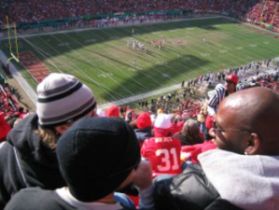11.3 - Geometric Examples
11.3 - Geometric ExamplesExample 11-1 Continued

A representative from the National Football League's Marketing Division randomly selects people on a random street in Kansas City, Kansas until he finds a person who attended the last home football game. Let \(p\), the probability that he succeeds in finding such a person, equal 0.20. And, let \(X\) denote the number of people he selects until he finds his first success. What is the probability that the marketing representative must select 4 people before he finds one who attended the last home football game?
Solution
To find the desired probability, we need to find \(P(X=4\), which can be determined readily using the p.m.f. of a geometric random variable with \(p=0.20\), \(1-p=0.80\), and \(x=4\):
\(P(X=4)=0.80^3 \times 0.20=0.1024\)
There is about a 10% chance that the marketing representative would have to select 4 people before he would find one who attended the last home football game.
What is the probability that the marketing representative must select more than 6 people before he finds one who attended the last home football game?
Solution
To find the desired probability, we need to find \(P(X>6)=1-P(X\le6)\), which can be determined readily using the c.d.f. of a geometric random variable with \(1-p=0.80\), and \(x=6\):
\(P(X >6)=1-P(X \leq 6)=1-[1-0.8^6]=0.8^6=0.262\)
There is about a 26% chance that the marketing representative would have to select more than 6 people before he would find one who attended the last home football game.
How many people should we expect (that is, what is the average number) the marketing representative needs to select before he finds one who attended the last home football game? And, while we're at it, what is the variance?
Solution
The average number is:
\(\mu=E(X)=\dfrac{1}{p}=\dfrac{1}{0.20}=5\)
That is, we should expect the marketing representative to have to select 5 people before he finds one who attended the last football game. Of course, on any given try, it may take 1 person or it may take 10, but 5 is the average number. The variance is 20, as determined by:
\(\sigma^2=Var(X)=\dfrac{1-p}{p^2}=\dfrac{0.80}{0.20^2}=20\)